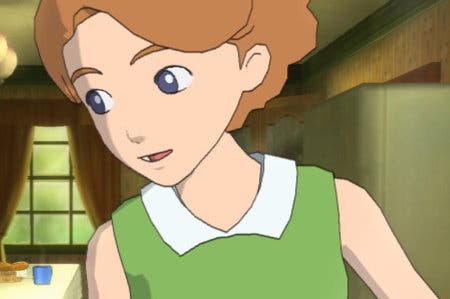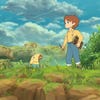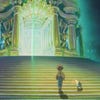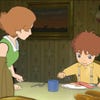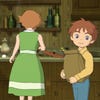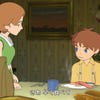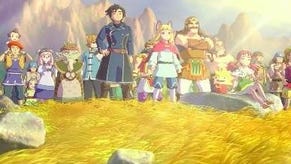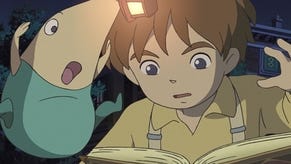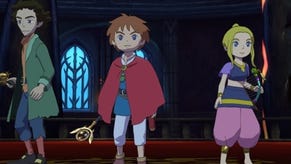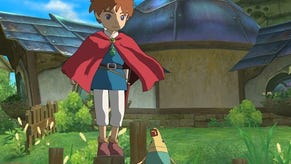Ni no Kuni Preview: Spirited Away
Level-5 and Studio Ghibli's adventure is an enchanting prospect - and an intriguing collaboration.
Last week, we had a chance to try out the Western version Ni no Kuni: Wrath of the White Witch, a collaboration between premier Japanese games studio Level-5 (Professor Layton, recent Dragon Quests) and celebrated anime outfit Studio Ghibli (Spirited Away, My Neighbour Totoro and dozens more classic animated films). We played the game shortly after the release of the eye-watering trailer that lays out the story of Oliver, the young boy whose stuffed toy - crafted by his deceased mother - is brought to life by his tears before the creature whisks him off on a grand adventure. It's true trauma escapism, in the style of Where the Wild Things Are or The Neverending Story.
The demo of this emotionally-charged adventure - a PS3 exclusive - was light but alluring, and showed off two different areas of the game, each restricted to a 10-minute taster. The first of these demos, appropriately titled Big Wide World, provided the opportunity to wander with Oliver and friends through a beautifully imagined 3D world: an otherwise typical Japanese RPG fairway made unique by its watercolour shading and free-flowing animations.
Strolling through the deep valley basin - not unlike wandering through the Welsh countryside - brings us to the village of Ding Dong Dell. In voicing the colourful characters that populate the town, the localisation team has drawn on its experience with Dragon Quest 8 to provide similarly charming regional accents. Outside of the village, further exploration takes place on a player-controlled boat, where enemies encountered on the rolling sea come aboard in order to do battle on the decks.
As a living, breathing cartoon, the game is a startling visual accomplishment. Oliver's cape billows around him as he runs among two-dimensional characters that come to life within the 3D world as you turn to look at them. Only in the cut-scenes that punctuate the action does the game fall back into the limited animation style so familiar to anime fans - the wide-eyed characters gasping in astonishment as the world transforms around them. It's an effective juxtaposition that startles and delights, and you're constantly reminded of the heritage that's been brought to the game through the developer's association with the animation studio.
The second section of the demo, entitled The Cradle of Industry, sees the party arriving in the city of Hamelin on a mission to meet with one of the city's great sages. Accompanied by new character Swain, the group travels through the steampunk Palace of the Porcine Prince, where heavily-armoured humanoid pigs guard the sides, before the building transforms to reveal an arena-like corridor, adoring crowds cheering as the sinister Prince and his cohorts pass by.
Studio Ghibli's involvement clearly runs deep, and the decree issued against making eye contact in the Palace of the Porcine Prince reminds me immediately of the bridge scene from Spirited Away where a spell can be broken with a single breath. It's eerie, mesmerising, dreamscape fantasy and it comes as no surprise to learn that the animations, characters and environments are all straight from Ghibli, while Level-5 set to work on the mechanics of the game.
Ni no Kuni is infused throughout with typically - heavily - traditional JRPG concepts, and it can't help but raise the spectre of comments made by Fez creator Phil Fish at this year's GDC on the relevance of Japanese games development within today's globalised industry. After our hands-on opportunity, we attend an interview session with Level-5 president and CEO Akihiri Hino to discuss this and other aspects of the game.
"We never really intended to protect, in a sense, the JRPG genre that's been known to Western audiences," Hino explains when the subject is put to him.
"It's very Japanese, and that's what we're keeping. But in terms of the game system, it doesn't necessarily follow the formula of past JRPGs. It keeps a Japanese feel, but it's still a new type of RPG, or new type of game."
That sense of familiarity is there in the menu-driven combat system, radial menus stacked upon characters, stacked upon pet combat options - a deep system with the options to drill down deeper into your combat pets, set up individual fighting tactics and manage spell-casting. As you juggle with your wide-ranging abilities, the camera whips and whirls between characters and bosses: a dynamic and cinematic combat mode that confuses at first but soon settles into the rhythm of a cartoon at play with itself.
If the micro-management feels too overpowering or detracts from the cinematic flow of the game, then a tactics system allows you to apply pre-set instructions to both your companions and your colleagues during combat: 'Keep us Healthy', 'Do What You Like', 'Provide Backup' and 'Don't Do Anything' are just a handful of the tactical options available.
"We can't go into specifics right now, but it's possible there will be additional creatures for the international version as well as potential DLC," explains Hino when asked about any aesthetic changes planned for the Westernised version, in addition to localising the game's million-plus lines of dialogue into English.
"That said, we are planning for other enhancements for the overseas version - we are in the midst of planning this out both internally and with Namco so we can't announce specifics. We are planning something additional."
Whether the collaboration between these two entertainment companies extends beyond the localised release of Ni no Kuni is not yet certain. But as game-makers jostle for exposure alongside their brothers in film and television, this style of partnership represents an intriguing possibility: mutual respect and collaboration on a unique new property rather than the more typical franchise cash-in (in either direction). Right now though, Hino can only speculate on the future of the partnership.
"We can say it's probable, but we can't really say much about it now. In terms of whether Ghibli will be working on any other games in the future, it's not really our position to state their ideas or directions with regards to their actions."
Ni no Kuni is as strong an argument as any that the Japanese development scene has more to offer the West than recent debate might have you believe. Level-5 has found personality in their game and ingenuity in their relationship with Studio Ghibli - and that relationship is helping to shake off some of the habitual crutches of the genre, while maintaining its grand tradition of escapist adventure.
